The variety that will become your favorite is the Grapefruit tomato: large, unpretentious in care and amazingly tasty
Among the great variety of tomatoes, bicolors, or two-colored, are very popular among vegetable growers. They are, as a rule, sweeter than monochromatic tomatoes and receive the highest tasting ratings in terms of taste.
Grapefruit is a typical bicolor variety. Its fruits, yellow with pink or pink-orange erosion, can reach 1.2 kg with proper care. This is a champion among tomatoes in taste and beauty.
The content of the article
Description of the variety
Plant indeterminate, non-standard, reaches 2 m in height, therefore, requires a garter and pinching. Tomatoes are disease resistant. Potato type leaf. The variety is mid-season (up to 180 days), yield - up to 9 kg per bush.
Tomatoes are large, flat-round, yellow-pink-orange at maturity, sometimes pink with yellow erosion. The weight of the fruit is 300-500 g, but some specimens reach 1 kg or even more. On the cut, the tomato pulp is yellow with pink stripes. The dry matter content is high, there are no chambers, and there are very few seeds. The taste is excellent: rich and sweet. Stored well.
A variety of salad purposes. The fruits are not suitable for whole fruit canning, but are good for making sauces.
How to grow seedlings
There are a huge number of methods for growing seedlings, and each vegetable grower chooses his own, proven over the years. However, new technologies are emerging that may interest gardeners. For example, the method of cropping the tops, or the Chinese method of growing seedlings, or rather, reproduction. It is best suited for tall tomatoes such as Grapefruit.
The advantages of the method:
- plants get sick less;
- bushes are more stocky and branched;
- higher productivity;
- increased resistance to stress;
- take root better after disembarking to a permanent place.
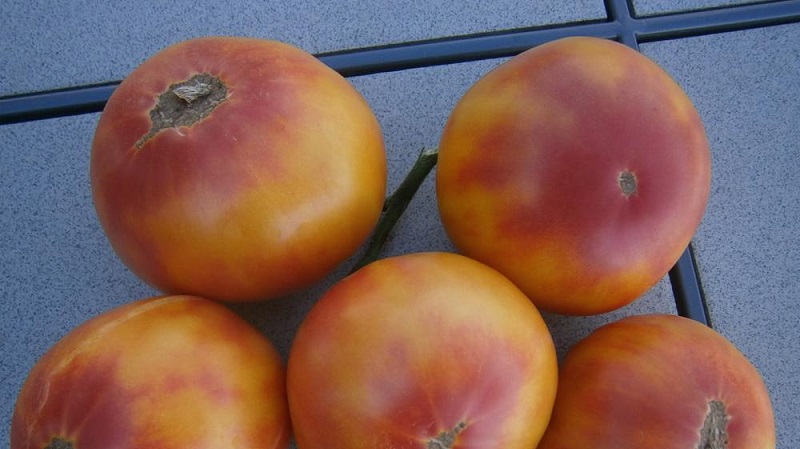
Seed preparation
Seeds are prepared for sowing in the traditional way. First, the largest ones are selected, then they are disinfected in a solution of brilliant green, without diluting, for 30 minutes, followed by washing and drying.
Capacity and soil
It is recommended to take containers for growing seedlings of sufficient volume and a height of approximately 10 cm for the successful development of the root system. If there are no holes in the containers, they must be made, for example, with a hot awl.
The soil for seedlings most often bought in supermarkets. It's nice to add agroperlite to the soil. It picks up excess moisture in case of overflow and gives it back in case of a shortage.
Sowing
The seeds are spread on a slightly compacted and moist soil spilled with Fitosporin solution. Then sprinkle with a layer of soil no more than 1 cm high and spray with water from a spray bottle.
Growing and care
A month after sowing, at the stage of 2-3 leaves, an "operation" is performed - cutting off the tops. On the eve, the plants are watered abundantly with water.
The procedure consists in the fact that the aerial part of the plant below the cotyledons is cut off and immediately placed in an aqueous solution of Epin.
Then the plants are transplanted into cups filled with soil and covered with a glass cover or plastic bag. This creates a greenhouse effect and improves rooting. After a few days, the plastic bag is removed and the plants are placed in a sunny place.
Important! The survival rate of tomatoes in this case is not 100%, part of the plants (20-30%) in novice gardeners may die.Therefore, it is advisable to calculate possible losses during sowing.
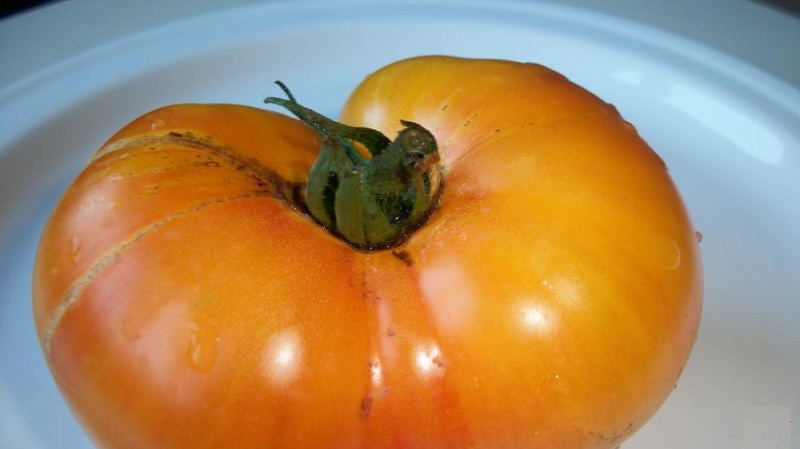
How to grow tomatoes
Planting seedlings in open ground is carried out when the danger of recurrent frosts has passed, and in closed - 1-2 weeks earlier.
Landing
Tomato Grapefruit is recommended to be grown indoors (greenhouse or greenhouse), although in the open field, as many growers testify, it gives a good harvest.
The soil is watered with Fitosporin solution two weeks before planting.
The distance between plants is kept 0.5 m from each other and 0.4 m between the rows.
In the holes for the seedlings add ½ humus, 1 tbsp. a spoonful of potassium sulfate, 1 tbsp. a spoonful of superphosphate, 1 glass of ash, 1 tbsp. a spoonful of fishmeal and mix.
Plants are placed in the prepared holes, orienting them from north to south, covered with earth and watered.
After 10 days, the plants are watered with a yeast solution (100 g of yeast per 10 l of water) so that the seedlings grow well and do not stretch out.
Care
Tomatoes don't like watering often. If it's not too hot, watering them once a week is enough.
Mandatory feeding with mullein and mineral fertilizers, which are carried out three times per season.
Foliar dressings are very good for development: with iodine, manganese, boric acid, "Epin", "Zircon", "Fitosporin", "HB-101". Spraying is carried out every 10 days.
In the heat, tomatoes are sprayed with a solution of boric acid or "HB-101" (preferably "HB-101", since the plants are damaged in case of an error in the dilution of boric acid).
During the flowering of the third brush, the plants are fed with a calcium solution in a ratio of 1 tbsp. spoon for 10 liters of water.
Required mulch soil with grass or hay. The thickness of the mulch layer is 8 cm.
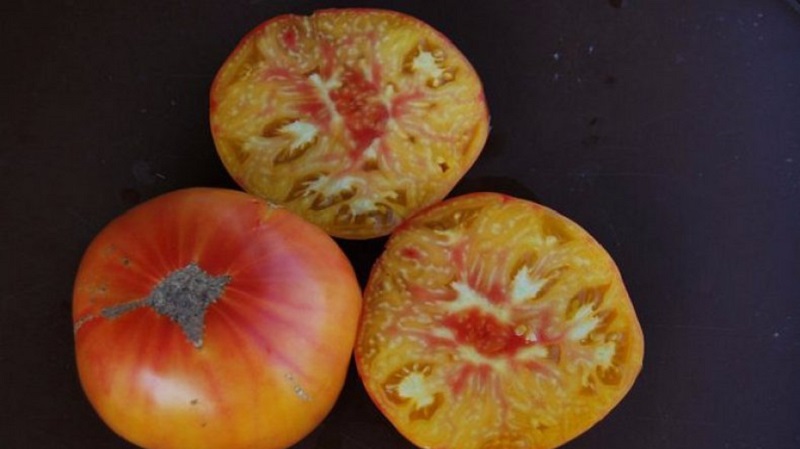
Features and possible difficulties
Tomato grapefruit requires the formation of 2-3 stems and a garter. As vegetable growers note, this variety is very photophilous, does not tolerate the slightest shading.
How to form a tomato bush? The first stepson left below the first brush, on the left - the main stem, on the right - the stepson - the second stem, and the stepson below the first stepson - the third stem. The rest of the stepsons are removed.
Particular attention should be paid to prevention late blight, as the fruits of the Grapefruit begin to ripen in late August - early September. To do this, it is necessary to improve the ventilation and illumination of plants: when tomatoes the size of a nut are tied on the brush, all the leaves under the brush are removed.
Attention! You cannot cut off many leaves at once, about two leaves a week!
Diseases and pests
Grapefruit is a disease-resistant tomato variety, but so that the plants do not get sick with late blight, the most common disease of tomatoes, the bushes are sprayed with solutions of "Trichodermina" and "Fitosporin" every two weeks.
The most common pest in tomatoes is the whitefly. The biological method of controlling it is the settlement of a parasitoid wasp, encarsia (Encarsia formosa), every two weeks in the form of infected puparia.
Spraying with Fitoverma solution helps well against other insect pests.
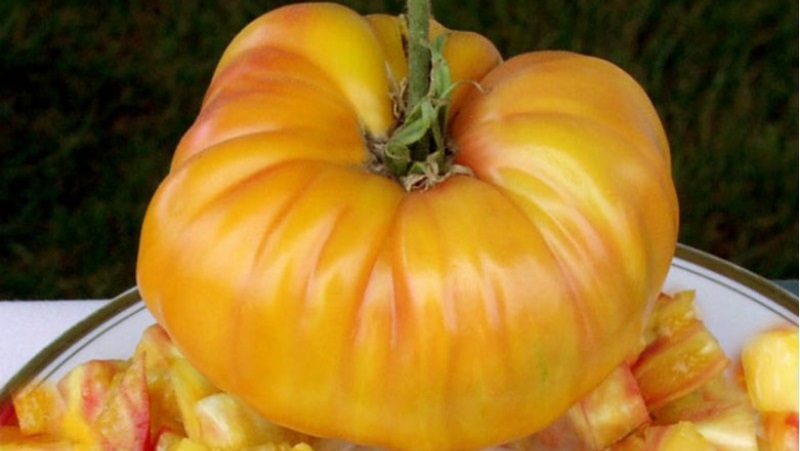
The nuances of growing in an open field and a greenhouse
Tomato Grapefruit is recommended to grow in a greenhouse primarily because of the late ripening of the fruit.
It is known that in a greenhouse tomatoes often suffer from extreme heat, but at temperatures above 40 ° C, tomato flowers are sterilized, therefore, no ovaries are formed.
To reduce the temperature in the greenhouse, the roof is covered with lutrasil, and the doors and windows are also opened.
When watering tomatoes in a greenhouse, the following rules are followed:
- water for irrigation should be at a temperature of 20-22 ° C;
- watered at the root, without touching the leaves;
- watered in the morning, because during the evening watering condensation forms, which favors the reproduction of pests and diseases.
Of course, on the one hand, it is better to grow tomatoes in a greenhouse. But on the other hand, varieties for closed ground are more troublesome and do not give such a bountiful harvest as for open ground. Don't chase the very best varieties, experiment and match your weather conditions. If the climate of the region permits, the Grapefruit variety can also be grown outdoors. With this method, the main thing is to choose the right landing site. It should be a sunny place without stagnant water, it is better where radishes, carrots, beet, cabbage, legumes, or salad.
The soil in the open field is fertilized in the same way as in the greenhouse.
Harvesting and application of the crop
The variety is late-ripening, therefore, fruit collection begins at the end of August and, if there is a greenhouse, ends, depending on weather conditions, in October.
Since the fruits are very beautiful and tasty, they can be a great gift for friends or a decoration for salads and other dishes. It is best to eat grapefruit tomatoes fresh.
Advantages and disadvantages of the variety
The advantages of grapefruit tomato include:
- amazing taste;
- rich aroma;
- unusual appearance and colors;
- good keeping quality;
- resistance to many diseases and pests;
- yield;
The disadvantages are the need garters and late ripeness.

Farmers reviews
Vegetable growers unanimously admire the taste and beauty of the Grapefruit tomato.
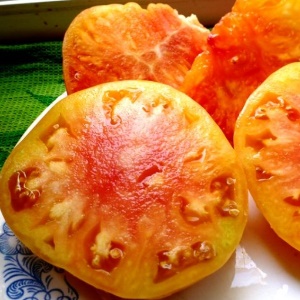 Nadezhda, Kaluga region: “My Grapefruit is a seed from Radish. Indeterminate, grew up to 1.5 m. Very tasty, but the yield is low, I will repeat and tame ”.
Nadezhda, Kaluga region: “My Grapefruit is a seed from Radish. Indeterminate, grew up to 1.5 m. Very tasty, but the yield is low, I will repeat and tame ”.
Ekaterina, Orsha: “Very fruitful - I am surprised myself. About 5 kg per bush is obtained - for me this is a lot. The bush is powerful, initially it led in two stems, now it seems to be growing at four. Late, fruits are large, sour, juicy. I repeated from my seeds, I realized that this variety does not tolerate the slightest shading - it grew in the middle of the central ridge. The yield and size of fruits are significantly lower than last year (then tomatoes grew right next to the entrance). "
Vitana, Izhevsk: “In 2015, I planted Grapefruit for the first time. In the greenhouse, he turned out to be one of the largest, although a little late, did not have time to prove himself in all his glory. I liked both the taste and the size! This year, Grapefruit surprised me and made me even more happy. Its fruits were the largest. The best harvest was on a bush that grew freely in a grape greenhouse. It grew in two stalks, was about 2 m high. On the upper clusters the tomatoes were even larger than on the lower ones. She took off the last fruits in October, recently ate the last one. The taste is very good! And handsome. "
Conclusion
Grapefruit tomatoes have a rich and exotic taste. Due to the extended ripening period in central Russia, it is most often grown in a greenhouse. Tomatoes fell in love with gardeners for their unusual two-tone color, sugary flesh and fruit size. Features of caring for the variety - the need for a garter and the formation of a bush.